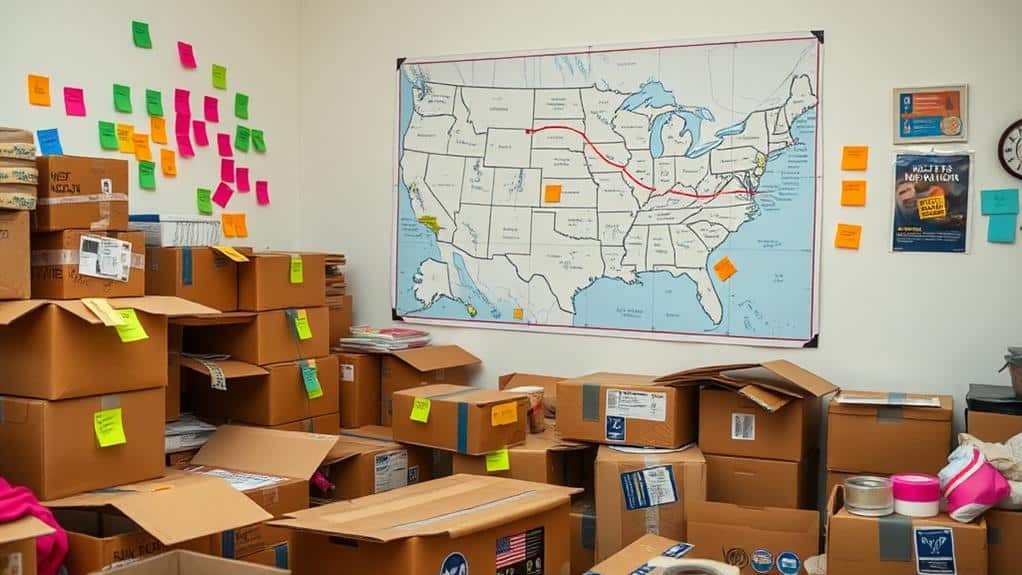Managing your move from California to New York involves several important steps. Start planning at least two months in advance, creating a timeline for packing, logistics, and utility management. Gather quotes from reliable movers and clarify the moving costs, which can range considerably. Declutter your belongings to save money and reduce hassle. On moving day, confirm everything is packed efficiently, clearly labeled, and that you've prepared an essentials box. Familiarize yourself with NYC's environment, especially public transportation, to make settling in easier. There's much more to explore about this process, so keep going to uncover valuable tips.
Planning Your Move

When you're gearing up for a move, starting your planning at least two months in advance can make all the difference.
Begin by creating a detailed timeline for packing, logistics, and managing utilities. This timeline helps guarantee a seamless shift from California to New York. The average moving time can range from 7 to 21 days, so it's vital to stay organized.
Next, gather multiple quotes from reputable movers. This step allows you to verify their credentials and insurance options, making sure you secure the best value for your move.
Don't forget to look into specific moving permits required for different NYC boroughs to avoid any fines or delays on moving day.
Another important tip is to declutter your belongings. Downsizing not only reduces the volume of items you'll need to manage during the move but can also greatly cut down on moving costs.
By focusing on planning, understanding your timeline, and taking the time to declutter, you'll set yourself up for a successful move from California to New York.
Understanding Moving Costs
Understanding moving costs is essential for a successful shift to your new home. When hiring movers from California to New York, it's important to know that the average cost can range from $2,511 to $16,021. This variation depends on the distance and the weight or volume of your items, as well as the specific needs of your move, which should be assessed for accurate cost estimation pricing methodology across companies.
To keep your moving costs manageable, consider the following tips:
- Downsize belongings: Reducing the number of items you move can greatly lower your expenses.
- Be aware of additional fees: Challenges like difficult access to buildings or long carries might increase your total cost.
- Get multiple quotes: Gathering estimates from different moving companies guarantees you find competitive pricing.
- Review insurance coverage: Federal law requires a minimum of $0.60 per pound for goods, but consider full-value coverage for better protection during long-distance moves.
Choosing the Right Movers
After you've got a handle on moving costs, the next step is selecting the right movers for your interstate journey. When you're moving from California to New York, start by prioritizing companies with a proven track record.
Consider seeking recommendations from friends or family, as they can lead you to reputable movers with specialized moving services. Make sure to verify their credentials, such as their US DOT numbers and state-specific licenses.
Gather and compare quotes from multiple moving services, as prices for long-distance moving can vary considerably, ranging from $2,511 to $16,021. Look for the best moving companies that offer full-value insurance options, since federal law only requires a minimum coverage of $0.60 per pound.
Reading customer reviews can provide valuable insights into the reliability and quality of service offered by the movers you're considering.
It's important to choose professional movers who understand the unique moving challenges of New York City, including local regulations, parking permits, and building access restrictions.
Packing Efficiently
Packing efficiently can make a world of difference on moving day, helping you save time and reduce stress. Start by investing in high-quality packing materials, like sturdy boxes and bubble wrap, to protect your belongings and minimize damage during transit.
It's important to follow packing guidelines to prevent damage, especially during long distance moves that can average 2,700 miles, so consider hiring professionals for packing services if you need assistance.
Before you pack, take some time to declutter your items; this won't only lighten your load but also lower moving costs based on weight and volume.
To make unpacking easier, label boxes with their contents and the room they belong to. This will streamline unpacking, letting you find essential items quickly. Speaking of essentials, create an essentials box that includes necessary items like toiletries, clothes, and important documents you'll need right away in New York.
Finally, maintain an inventory list of all the items you're packing. This will help you track what's been loaded and guarantee nothing gets lost along the way.
Here are some tips to keep in mind:
- Use high-quality packing materials
- Declutter before packing
- Label boxes clearly
- Create an essentials box
Settling Into New York

Once you've successfully packed up your belongings and arrived in New York, it's time to embrace your new surroundings. Moving to New York can be an adventure filled with vibrant urban life and unique challenges. Start by familiarizing yourself with the public transportation system, especially the subway, as it's essential for traversing the city efficiently. This will help you save money and time while getting to know different neighborhoods like Brooklyn Heights and Greenwich Village.
Additionally, as you settle into your new small space, consider strategies for small space living that can optimize your home and enhance your lifestyle.
Next, consider your lifestyle changes. New Yorkers face four distinct seasons, so investing in appropriate wardrobe essentials for icy winters and humid summers is a must. Building a social network is vital, too. Attend local events, join clubs, or volunteer to meet new people and integrate into the New York narrative.
Exploring cultural opportunities can greatly enhance your adaptation experience. By engaging with local communities, you'll not only find new friends but also discover the diverse amenities and green spaces that make New York special.
Keep your moving checklist handy and check off tasks as you settle in, ensuring a smooth adjustment to your exciting new home.
Navigating NYC's Environment
When you're moving in NYC, it's important to take into account the seasonal weather, as it can impact your plans.
Mastering public transportation will also make getting around easier, especially if you're carrying boxes or furniture.
Seasonal Weather Considerations
How can you best prepare for moving day in New York City's unpredictable weather? Seasonal weather considerations are essential when planning your move.
NYC experiences icy winters with temperatures around 32°F and hot, humid summers averaging 85°F. To make your moving preparations easier, consider scheduling your move during the milder spring or fall months to avoid extreme weather conditions.
Here are some tips to help you prepare:
- Check the weather forecasts regularly leading up to your move.
- Dress appropriately for the weather on moving day, layering for unexpected changes.
- Be prepared for heavy rainfall in spring, as it can lead to flooding and delays.
- Know your public transportation options to navigate the city during adverse weather conditions.
Mastering Public Transportation
Maneuvering New York City's extensive public transportation system can feel overwhelming, but mastering it is key to a smooth moving day. With over 472 subway stations operating 24/7, the NYC subway system is an essential part of getting around. Be sure to get a MetroCard, which costs $2.75 per ride and allows you to access different routes throughout the city.
To steer efficiently, download transit tracking apps like Citymapper or Google Maps. These apps provide real-time updates on subway and bus schedules, helping you avoid crowded travel times.
The NYC bus system complements the subway, featuring over 300 routes and allowing for seamless transfers with your MetroCard.
Keep in mind that peak commuting hours are from 7 AM to 9 AM and 5 PM to 7 PM, which means trains and buses can be especially crowded. Plan your trips outside these times if possible.
Tips for a Smooth Transition

To guarantee a smooth shift on moving day, start by creating a pre-move checklist that covers all essential tasks, including understanding the guaranteed pricing offered by your moving service.
Organizing your packing strategies can help simplify the process, making it easier to find what you need when you arrive.
Pre-Move Checklist Essentials
Moving can feel overwhelming, but a well-organized pre-move checklist can make all the difference in ensuring a smooth shift.
Start by creating a detailed timeline for packing at least a month in advance. This will help you systematically organize and label items to streamline the moving process. Remember to declutter your belongings; identify what you can sell, donate, or discard to ease the changeover and reduce moving costs.
Here are some checklist essentials to help you prepare:
- Gather multiple quotes from licensed and insured moving companies to secure the best value for your move.
- Prepare an essentials box with items you'll need immediately, like toiletries, clothing, and important documents.
- Notify utility companies of your move and complete a change of address form with USPS at least two weeks prior.
- Consider using moving services that offer packing assistance if you need an extra hand.
Packing Strategies Simplified
When it comes to packing for your move, starting early can save you a lot of stress later on. Begin by creating a detailed inventory of your belongings. This list will help you track everything during the move.
High-quality packing materials are essential to protect your items in transport, so invest in sturdy boxes and cushioning. As you pack, declutter your belongings; identify what to sell, donate, or discard. This not only reduces moving costs but also makes packing easier.
Don't forget to label boxes clearly. This will simplify unpacking and help you find what you need quickly. Pack an essentials box with necessary items like clothes, toiletries, and important documents. This guarantees you have immediate access to what you need upon arrival in New York.
If you have valuable or fragile items, consider hiring professional packers. They're trained to handle these items carefully and often provide full-value insurance coverage for peace of mind.
Conclusion
Moving from California to New York can feel like jumping from a sunny beach into a bustling city. Just as you'd pack your surfboard carefully to avoid damage, you'll want to plan each step of your move with care. By understanding costs, choosing reliable movers, and packing efficiently, you can make your shift smoother. Embrace the change, explore your new surroundings, and remember that every great adventure starts with a single step. Welcome to your new chapter!


